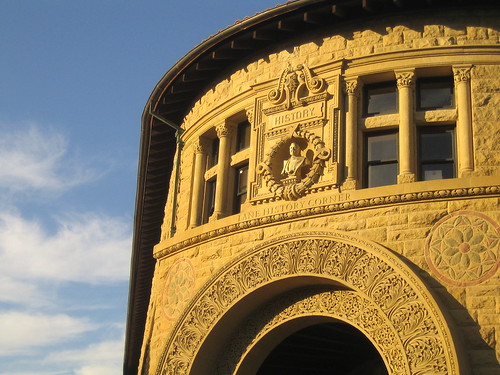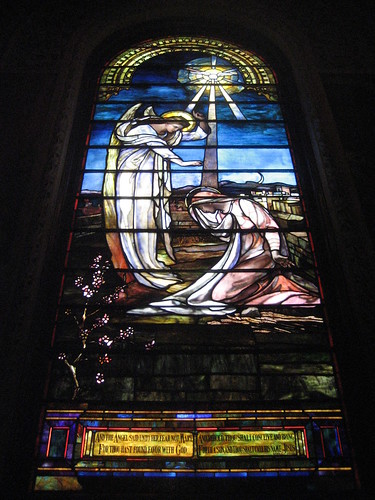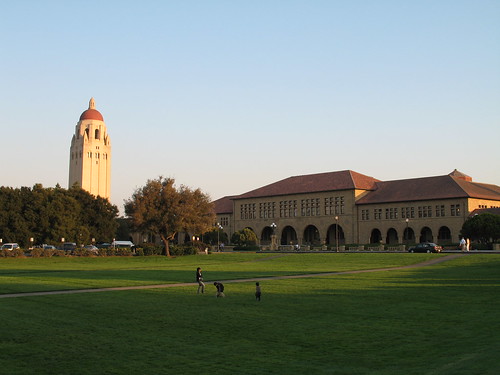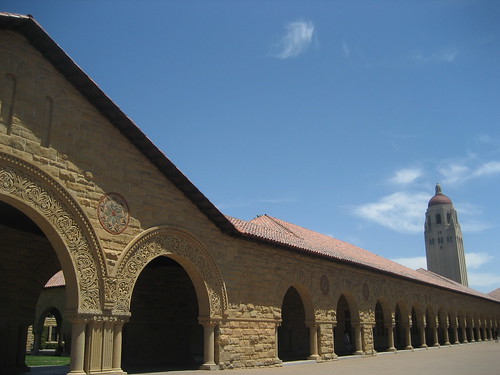
I first visited the campus of Stanford University in late June of 1995. The northern California summer had settled in, and the campus was all flax and brown, dusty and dried out, and emptied of students. Walking around campus, heat radiated off the asphalt and stone, and only under the cool archways of Old Union or the main Quad could you find any respite. The place felt like a ghost town, and I planned on not attending.
In the spring of 1996, I made a return visit to campus, this time with admittance letter in hand. Partly due to legitimate conflict, partly due to my contrarian ways, I turned up on a Thursday night, a full week before admit weekend, and spent a quiet couple of days wandering around campus, mostly on my own, mostly not meeting anybody, students or professors.
During this visit, a funny thing happened, and that funny thing was that I fell in love with the campus. The grounds themselves - the gardens, the secluded patios, the abstract sculptures, and the strange and compelling post-modern buildings scattered on the outskirts of the Spanish colonial center of campus. It struck me as a wonderful place to be thoughtful.

 In my years on campus, the grounds were equal part playground and muse, providing the setting for many mornings, afternoons, and nights of architectural exploration, the backdrop for much of our more lucid forays into short film-making, and generally, a beautiful place in which to mess around.
In my years on campus, the grounds were equal part playground and muse, providing the setting for many mornings, afternoons, and nights of architectural exploration, the backdrop for much of our more lucid forays into short film-making, and generally, a beautiful place in which to mess around.
Now, anytime I return to northern California after an absence, and with a few days on my hands, I drive down to campus and spend a couple of hours walking around. While the campus has many beautiful secrets scattered throughout, the most stunning is still the most prominent - the original Stanford Quad.
 Built in the Mission Revival style in the 1890s, based on plans by Frederik Law Olmsted, the sandstone arcades, red-tiled roofs, and the pink-tile latticed ground stones create an atmosphere of sturdy calm from which to absorb the rich textures of light and shadow. The perfect geometries of the Quad, which stretch from University Avenue to 101 in the East, through Memorial Church and into the foothills, and further, the Pacific and the setting sun in the West, and currently, bisect Green library to the south and the prows of the ship-like face of the technology park, laid on the same axis, to the North, lend a sense of precision and mathematical formality - establishing a baseline of order and intention to the place. And the gem in the crown, Memorial Church itself, with its gilt mosaic face, cool, wooden interior, awash in rich light from the stained glass-lined nave, with its graceful and contemplative organ emoting its quiet plaints most days and some nights, provides an aura of holiness to an otherwise secular campus.
Built in the Mission Revival style in the 1890s, based on plans by Frederik Law Olmsted, the sandstone arcades, red-tiled roofs, and the pink-tile latticed ground stones create an atmosphere of sturdy calm from which to absorb the rich textures of light and shadow. The perfect geometries of the Quad, which stretch from University Avenue to 101 in the East, through Memorial Church and into the foothills, and further, the Pacific and the setting sun in the West, and currently, bisect Green library to the south and the prows of the ship-like face of the technology park, laid on the same axis, to the North, lend a sense of precision and mathematical formality - establishing a baseline of order and intention to the place. And the gem in the crown, Memorial Church itself, with its gilt mosaic face, cool, wooden interior, awash in rich light from the stained glass-lined nave, with its graceful and contemplative organ emoting its quiet plaints most days and some nights, provides an aura of holiness to an otherwise secular campus.
Walking around now is less an act of nostalgia then a momentary pause to reconnect with a truly special place - a testament to how buildings and architecture can really enrich our daily lives.



In the spring of 1996, I made a return visit to campus, this time with admittance letter in hand. Partly due to legitimate conflict, partly due to my contrarian ways, I turned up on a Thursday night, a full week before admit weekend, and spent a quiet couple of days wandering around campus, mostly on my own, mostly not meeting anybody, students or professors.
During this visit, a funny thing happened, and that funny thing was that I fell in love with the campus. The grounds themselves - the gardens, the secluded patios, the abstract sculptures, and the strange and compelling post-modern buildings scattered on the outskirts of the Spanish colonial center of campus. It struck me as a wonderful place to be thoughtful.

 In my years on campus, the grounds were equal part playground and muse, providing the setting for many mornings, afternoons, and nights of architectural exploration, the backdrop for much of our more lucid forays into short film-making, and generally, a beautiful place in which to mess around.
In my years on campus, the grounds were equal part playground and muse, providing the setting for many mornings, afternoons, and nights of architectural exploration, the backdrop for much of our more lucid forays into short film-making, and generally, a beautiful place in which to mess around.Now, anytime I return to northern California after an absence, and with a few days on my hands, I drive down to campus and spend a couple of hours walking around. While the campus has many beautiful secrets scattered throughout, the most stunning is still the most prominent - the original Stanford Quad.
 Built in the Mission Revival style in the 1890s, based on plans by Frederik Law Olmsted, the sandstone arcades, red-tiled roofs, and the pink-tile latticed ground stones create an atmosphere of sturdy calm from which to absorb the rich textures of light and shadow. The perfect geometries of the Quad, which stretch from University Avenue to 101 in the East, through Memorial Church and into the foothills, and further, the Pacific and the setting sun in the West, and currently, bisect Green library to the south and the prows of the ship-like face of the technology park, laid on the same axis, to the North, lend a sense of precision and mathematical formality - establishing a baseline of order and intention to the place. And the gem in the crown, Memorial Church itself, with its gilt mosaic face, cool, wooden interior, awash in rich light from the stained glass-lined nave, with its graceful and contemplative organ emoting its quiet plaints most days and some nights, provides an aura of holiness to an otherwise secular campus.
Built in the Mission Revival style in the 1890s, based on plans by Frederik Law Olmsted, the sandstone arcades, red-tiled roofs, and the pink-tile latticed ground stones create an atmosphere of sturdy calm from which to absorb the rich textures of light and shadow. The perfect geometries of the Quad, which stretch from University Avenue to 101 in the East, through Memorial Church and into the foothills, and further, the Pacific and the setting sun in the West, and currently, bisect Green library to the south and the prows of the ship-like face of the technology park, laid on the same axis, to the North, lend a sense of precision and mathematical formality - establishing a baseline of order and intention to the place. And the gem in the crown, Memorial Church itself, with its gilt mosaic face, cool, wooden interior, awash in rich light from the stained glass-lined nave, with its graceful and contemplative organ emoting its quiet plaints most days and some nights, provides an aura of holiness to an otherwise secular campus.Walking around now is less an act of nostalgia then a momentary pause to reconnect with a truly special place - a testament to how buildings and architecture can really enrich our daily lives.



No comments:
Post a Comment